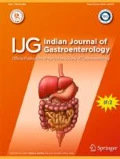Abstract
Background
The etiology of corrosive esophageal strictures is different from that reported in Western literature, with acid ingestion being a major cause. This study evaluated functional and morphological changes in the colon used as neoesophagus.
Methods
Functional changes in the neoesophagus were evaluated by symptom score of dysphagia and manometry. Barium study and fluoroscopy were done to evaluate the flow patterns and endoscopy with histopathological examination to study the adaptive changes in the colon.
Results
Thirty-five patients with corrosive injury presented between 2007 and 2010. Isolated esophageal involvement was seen in 22 patients; 11 of them underwent colonic replacement. The passage of barium was smooth, without any hold up at the upper or lower anastomotic line. Endoscopic biopsy at 6 months and 1 year did not show any change in the mucosal pattern or in the muscularis layer of the transposed colon. Functional evaluation showed relief of dysphagia in all 11 patients after surgery. The mean preoperative dysphagia score was 7.81 (range 5–10), at 1 month was 0.73 (range 0–2), and at 3 months post-surgery was 0.45 (range 0–2). Manometric study at 3 months after the surgery in all 11 patients and in five patients at the end of 6 months showed no evidence of peristalsis in the neoesophagus. Three of the latter five patients demonstrated a 4–5-cm zone with a high pressure in the intraabdominal part of the transposed colon compared with that in the intrathoracic part of the colon. On barium studies, reflux from the stomach into the neoesophagus was not seen in any of the 11 patients.
Conclusions
Esophagocoloplasty was associated with symptom relief, and the reflux of gastric content was low because of 4–5 cm of the colon being intraabdominal in a positive pressure environment.







Similar content being viewed by others
References
Maull K, Scher LA, Greenfield LJ. Surgical implications of acid ingestion. Surg Gynaec Obstet. 1979;148:895–8.
Belsey R. Reconstruction of the oesophagus. Ann R Coll Surg Engl. 1983;65:360–4.
Yeo CY. Shackelford’s Surgery of the Alimentary Tract. 6th ed. Philadelphia: Saunders; 2002. p. 545.
Kotsis L, Krisár Z, Imre J, Csikos M. Complications of oesophagoplasty with isoperistaltic transverse colon. Scand J Thorac Cardiovasc Surg. 1983;17:317–21.
Thomas P, Fuentes P, Giudicelli R, Reboud E. Colon interposition for esophageal replacement: current indications and long-term function. Ann Thorac Surg. 1997;64:757–64.
Benages A, Moreno-Ossett E, Paris F, et al. Motor activity after colon replacement of esophagus. J Thorac Cardiovasc Surg. 1981;82:335–40.
París F, Tomas-Ridocci M, Galan G, et al. The colon as oesophageal substitute in non-malignant disease. Long-term clinical results and functional studies. Eur J Cardiothorac Surg. 1991;5:474–8.
Ritchie JA. Colonic motor activity and bowel function. Part I. Normal movement of contents. Gut. 1968;9:442–56.
Jeyasingham K, Lerut T, Belsey RHR. Functional and mechanical sequelae of colon interposition for benign oesophageal disease. Eur J Cardiothorac Surg. 1999;15:327–32.
Gerzic ZB, Knezevic JB, Milicevic MN, Jovanovic BK. Esophagocoloplasty in the management of postcorrosive strictures of the esophagus. Ann Surg. 1990;211:329–36.
Kotsis L, Krisár Z, Orbán K, Csekeö A. Late complications of coloesophagoplasty and long-term features of adaptation. Eur J Cardiothorac Surg. 2002;21:79–83.
Acknowledgments
We thank Ms Megha Meshram, Senior Technician Manometry, Department of Medical Gastroenterology, for performing manometry.
Conflict of interest
None
Author information
Authors and Affiliations
Corresponding author
Rights and permissions
About this article
Cite this article
Prabhu, R., Kantharia, C., Bapat, R. et al. Morphological and functional changes in colon after coloplasty for management of corrosive esophageal strictures. Indian J Gastroenterol 32, 165–171 (2013). https://doi.org/10.1007/s12664-013-0320-7
Received:
Accepted:
Published:
Issue Date:
DOI: https://doi.org/10.1007/s12664-013-0320-7




